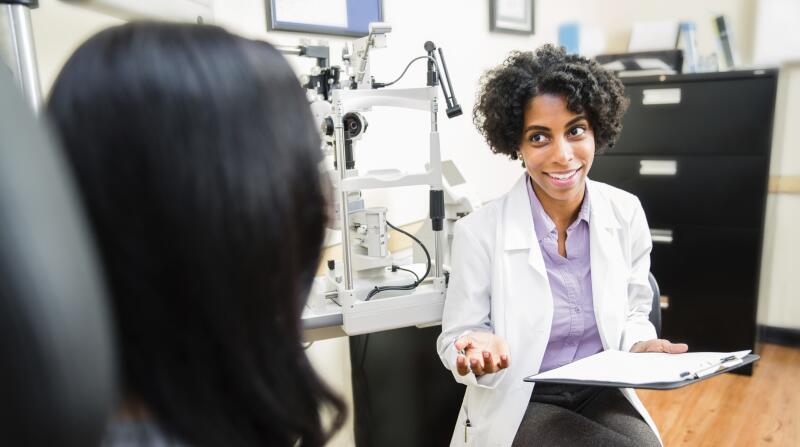PHYSICIAN VOICES
4 Tips for Choosing Dry Eye Treatments
-
 Finding the Right Treatment for Dry EyesWhen your eyes are healthy, you don’t really notice how they feel. But when you’re suffering from chronic dry eye, you may feel pain, burning, scratching, and irritation in your eyes. With dry eye disease, your eyes don’t produce enough tears, or those tears evaporate too quickly. Fortunately, there are many different treatment options out there to relieve symptoms and help the eyes produce more tears. An eye doctor, or ophthalmologist, like me, can recommend over-the-counter (OTC) artificial tears for mild cases, or you might need prescription eye drops to lower the inflammation in your eye. Follow these tips to make sure you’re getting the best treatment for your dry eyes.
Finding the Right Treatment for Dry EyesWhen your eyes are healthy, you don’t really notice how they feel. But when you’re suffering from chronic dry eye, you may feel pain, burning, scratching, and irritation in your eyes. With dry eye disease, your eyes don’t produce enough tears, or those tears evaporate too quickly. Fortunately, there are many different treatment options out there to relieve symptoms and help the eyes produce more tears. An eye doctor, or ophthalmologist, like me, can recommend over-the-counter (OTC) artificial tears for mild cases, or you might need prescription eye drops to lower the inflammation in your eye. Follow these tips to make sure you’re getting the best treatment for your dry eyes. -
 1. Choose preservative-free OTC eye drops.Patients with mild dry eye often benefit from artificial tears available over the counter. There are many options out there, but if you’re going to be using the eye drops frequently throughout the day, I recommend purchasing the preservative-free kind. Eye drops with preservatives in them last longer, but they can irritate the surface of your eye with frequent use (i.e. more than 4 to 6 times a day), which makes the dry eye symptoms worse.
1. Choose preservative-free OTC eye drops.Patients with mild dry eye often benefit from artificial tears available over the counter. There are many options out there, but if you’re going to be using the eye drops frequently throughout the day, I recommend purchasing the preservative-free kind. Eye drops with preservatives in them last longer, but they can irritate the surface of your eye with frequent use (i.e. more than 4 to 6 times a day), which makes the dry eye symptoms worse. -
-
 2. Choose the right artificial tear thickness for your eyes.Artificial tears come in different thickness levels, and patients with more severe dry eye need a thicker treatment. You can try an eye drop, a thicker gel drop, or an ointment. The ointments are the thickest and I often recommend them to patients who have significant dry eye symptoms in the morning as the ointment moisturizes the eye overnight. They are also useful for patients who have exposure issues in their eyes from incomplete eyelid closure conditions. Patients who have a lot of dryness at night and in the morning should try gels or ointments, which last longer than eye drops. Talk to your doctor about your specific concerns for advice on which type of artificial tear is best for you.
2. Choose the right artificial tear thickness for your eyes.Artificial tears come in different thickness levels, and patients with more severe dry eye need a thicker treatment. You can try an eye drop, a thicker gel drop, or an ointment. The ointments are the thickest and I often recommend them to patients who have significant dry eye symptoms in the morning as the ointment moisturizes the eye overnight. They are also useful for patients who have exposure issues in their eyes from incomplete eyelid closure conditions. Patients who have a lot of dryness at night and in the morning should try gels or ointments, which last longer than eye drops. Talk to your doctor about your specific concerns for advice on which type of artificial tear is best for you. -
 3. Avoid eye drops marketed towards reducing redness.Vasoconstrictors are eye drops that constrict blood vessels in the eye, reducing eye redness; however, they’re not recommended for patients looking for relief from dry eye. It’s common for dry eye patients to experience redness as a result of eye irritation, but lubricating the eyes with artificial tears will help resolve dryness and redness. In fact, redness-reducing drops may actually make dry eyes worse over time.
3. Avoid eye drops marketed towards reducing redness.Vasoconstrictors are eye drops that constrict blood vessels in the eye, reducing eye redness; however, they’re not recommended for patients looking for relief from dry eye. It’s common for dry eye patients to experience redness as a result of eye irritation, but lubricating the eyes with artificial tears will help resolve dryness and redness. In fact, redness-reducing drops may actually make dry eyes worse over time. -
 4. For more serious cases, try a prescription eye drop.With moderate to severe cases of dry eye, I’ll prescribe patients medicated eye drops. Currently, there are two approved by the Food and Drug Administration (FDA) to treat dry eye: cyclosporine (Restasis) and lifitegrast (Xiidra). Both products work to reduce inflammation in the eye, which allows for more tear production, easing dry eye symptoms. I do caution patients that these drugs won’t work immediately; most patients don’t start seeing results until they’ve been taking the medicines for a few weeks or even a few months. To cover the gap, I may prescribe a temporary steroid drop or recommend patients use OTC artificial tears until the medications kick in.
4. For more serious cases, try a prescription eye drop.With moderate to severe cases of dry eye, I’ll prescribe patients medicated eye drops. Currently, there are two approved by the Food and Drug Administration (FDA) to treat dry eye: cyclosporine (Restasis) and lifitegrast (Xiidra). Both products work to reduce inflammation in the eye, which allows for more tear production, easing dry eye symptoms. I do caution patients that these drugs won’t work immediately; most patients don’t start seeing results until they’ve been taking the medicines for a few weeks or even a few months. To cover the gap, I may prescribe a temporary steroid drop or recommend patients use OTC artificial tears until the medications kick in.
Your Opinion Matters!
In order to improve our content, we want to hear from you. Please take this short anonymous survey to let us know how we’re doing.
Take the survey!
Dry Eye Treatments | Chronic Dry Eye















